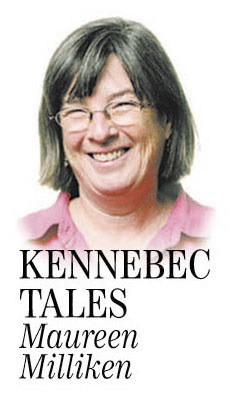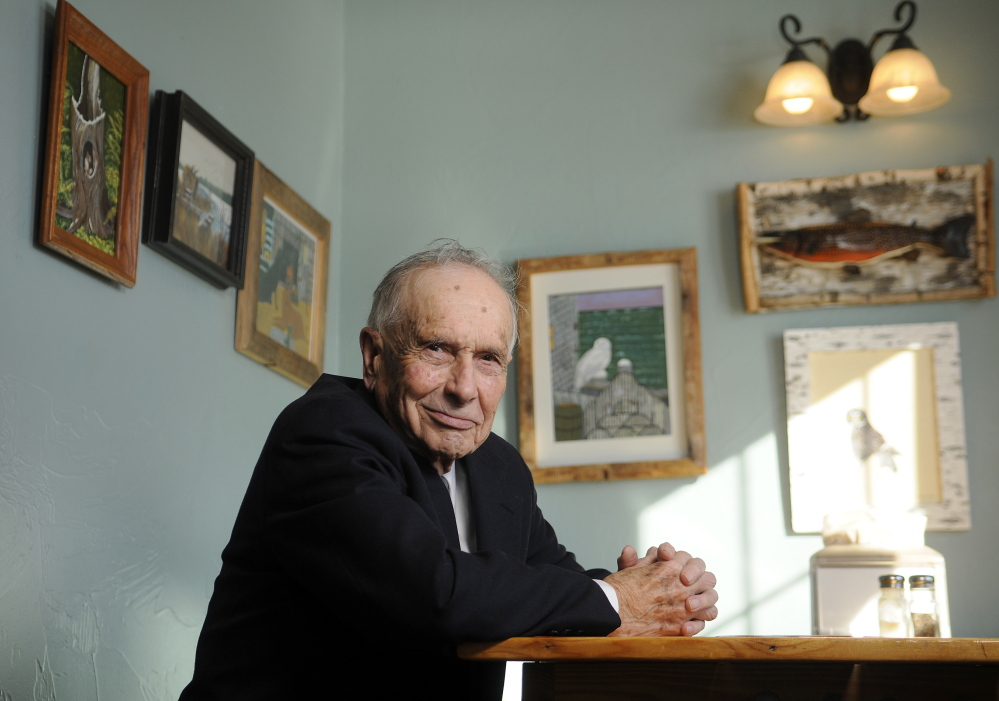Ezra Smith spent the first half of his life not knowing he was an artist.
Smith, 90, worked his way up the ladder at Wilson’s Dollar Stores, never touching paint or any other implements of art, unless it was to put them on a shelf.
But when he retired at 55, he needed something to do.
“My father died when he was 64, so I thought I’d have 10 years,” Smith said recently on a cold sunny morning at the Post Office Cafe in Mount Vernon.
He stopped working and started carving.
The Winthrop resident joined the Maine Wildlife Woodcarvers Association, and things just kind of took off from there.
This month his work is on display at the Post Office Cafe, hanging on the walls and filling the empty floor space. Owner Bob Wallack, who died Tuesday, made it a point to feature an artist every month.
While carved loons are Ezra Smith’s specialty — “I gave him (or her) a loon,” is a frequent interjection in any conversation — his art goes way beyond them.
Painting, sculpture, two-dimensional woodworks — so much art that the 40 or so pieces at the restaurant are just a sample.
Another one of his specialties is carved fish on a wood background, a rustic take on the stuffed bass trophy. Colorful and simple at the same time, they are beautiful.
Wallack had discussed the show with Smith for the past six months, said George Smith, Smith’s son, Wednesday.
Earlier this month, Wallack, though he was ill, visited the cafe with his wife, Vicki, to check the show out.
“Both Vicki and I were blown away with your dad’s work,” Wallack said in an email to George. “It is a great show, well curated, with tremendous appeal and really captures what appears to be decades of work and changing style. We love every piece and are proud to showcase Ezra’s talent. It is a wonderful example of highly crafted folk art at its best.”
George Smith said he plans to frame the message and add it to the collection.
Despite the accolades, Ezra doesn’t consider himself an artist and is reluctant to take money for his work, giving most of it away or donating it to fundraisers. Copies of a painting of the mill in Mount Vernon are sold to raise money for a food pantry, for instance.
After George remarked that almost all the art on display in the cafe is for sale, Ezra disagreed.
“Yes it is,” George said.
“I wouldn’t pay for it,” Ezra retorted.
But many would, including admirers from as far away as Texas and Arizona, who have already laid claim to some of the art on display at the restaurant.
A small brochure printed to accompany the exhibit points out that “he does occasionally sell an item, but feels money detracts from the value and satisfaction of his work.”
Humble as he is, his family is proud and sees how special Ezra’s art is.
“I tell him how good he is, but he thinks I’m prejudiced,” said his lady friend, Irma Rice, also of Winthrop. “But if he was anyone else, I’d still think it was good.”
George thinks so, too. “Isn’t this stuff great?” he said, walking around the restaurant, pointing out pieces and talking about the history or inspiration behind them.
George, a well-known outdoorsman and columnist for the Kennebec Journal and Morning Sentinel, can identify the fish and birds in the paintings and carvings, but also sees the unique detail, down to the tied fly in the mouth of the mounted carved fish.
Ezra, a lifetime fisherman and hunter, draws almost exclusively from nature. But like a true Maine outdoorsman, he isn’t sentimental about it.
Pointing out a painting of a snowy owl, he said, “That’s one I shot.”
With a camera?
“No, I shot it and stuffed it.” (Don’t worry, this was when he was a teenager, long before the owls were protected).
He chuckles at the memory.
“Lots of these are of animals he’s seen, caught or shot,” George said.
But don’t let the pragmatic Maine attitude fool you. It’s impossible to create art without a heart, whether it’s of bass or snowy owls or something closer to home.
When the house in Lubec where his late wife, Ada, grew up burned down, Smith took a ride Downeast and got bricks from the ruins, using them as a canvas to paint pictures of the house for family members.
Most of his art is on found objects like driftwood and old barn boards. He’s buys his paint at yard sales.
He doesn’t like waste, and that perspective is also what helps him see art everywhere around him.
His house is full of not only his stuff, but other people’s work.
“Incredible stuff,” George said.
His casket is a half-canoe carved by an artist friend.
“We’re not planting that in the ground,” George said, as Ezra protested.
While he’s modest about his own talent (“I’m Grandpa Moses — very, very old and very, very crude” he joked), he’s generous about others, describing one woodcarver as “a genius,” and when the name of another carver comes up in conversation, Smith said, “Now HE’S good.”
Smith grew up in Wayne and Readfield. He went to Kents Hill Academy and then went to work. He started as a clerk at Wilson’s and worked his way up to ownership, selling his partnership to another owner when he retired.
It’s the story of a hard-working man from a tough generation. But even about that, he’s modest. Remarking that he always found time to hunt, fish and be outdoors, he says of his career, “I loafed more than I worked.”
He also used to ride a bicycle everywhere, including to work, way before it was cool for adults to ride bicycles.
“He was ahead of his time,” George said.
His family and friends are having a private reception for him next week at the restaurant to celebrate his art, and his extraordinary life. His family extends now to a bunch of great-grandchildren, with artists and writers sprinkled through the generations. He’s impressed by the talent, and shrugs off that it’s in the DNA.
It’s hard for people who don’t create art to imagine what drives someone who does, particularly someone who started after more than five decades of never touching it and is now so prolific.
Maybe it’s hard for the guy who worked hard, but naturally immersed himself in and loved the beauty around him to imagine, too.
Smith brushes away questions of the how and why.
Asked what drives him to create, he says, “Anytime you can make a fish with birch bark, it’s fun.”
Maureen Milliken is news editor of the Kennebec Journal and Morning Sentinel Email her at mmilliken@centralmaine.com. Kennebec Tales appears the first and third Thursday of the month.
Send questions/comments to the editors.



